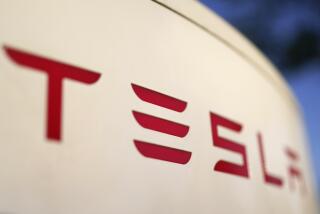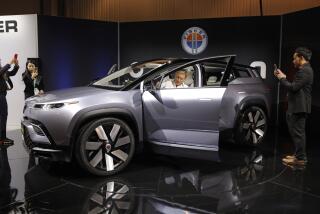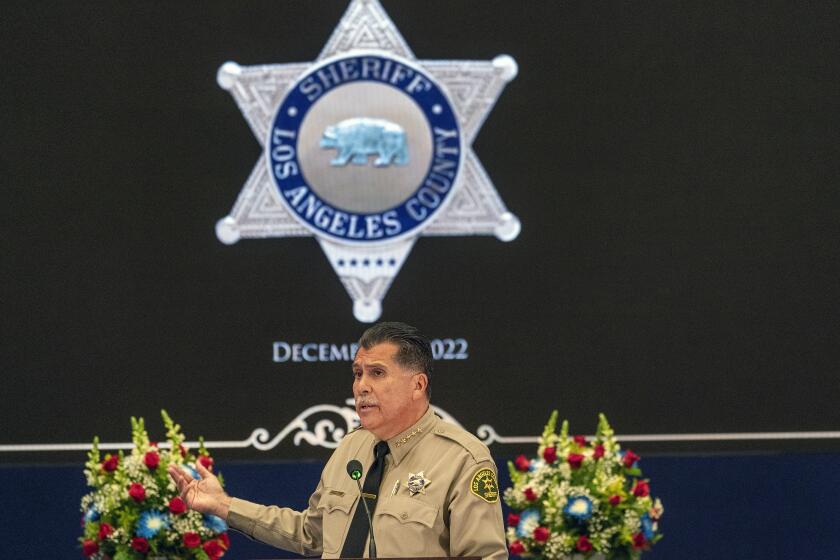Ferrari Owner Had Other ‘Crash’
Stefan Eriksson had hoped that millions of video gamers would experience the thrill of street racing on a hand-held device he helped develop. But then Eriksson’s $1-million Ferrari was totaled, an accident that gamers around the world may see as a cruel metaphor for the collapse of the portable console company.
Eriksson was a top executive for Gizmondo, a European video game system maker that two years ago garnered international headlines by challenging Sony and Nintendo with its own PSP-like device.
Eriksson received a $100,000 car allowance from the firm, according to records from the Securities and Exchange Commission, and drove in Le Mans, the famous French motor race, in a Ferrari plastered with Gizmondo signs.
The game company launched last year with a gala in London that included a performance by the pop star Sting. One of the firm’s games, Chicane, involved exotic car racing.
But on the eve of Gizmondo’s U.S. launch last fall, Eriksson resigned from the firm while in Los Angeles to market the device. His resignation came days before a Swedish newspaper alleged that Eriksson had been convicted of counterfeiting in the Scandinavian country in the early 1990s.
The company quickly collapsed, unable to sell enough devices to justify to game makers that they should supply more titles for the Gizmondo format. Loans could not be repaid, and the company incurred net losses exceeding $100 million, according to the SEC records.
The company’s name is now a synonym for hubris in the game world, which was enrapt Wednesday with the news that Eriksson’s lavish Italian sports car had been wrecked.
“The Gizmondo was bad enough but now this?” wrote one reader on the electronic game website gamespot.com.
“And you wonder why they went bankrupt,” another gamer wrote.
Eriksson, 44, declined to be interviewed Wednesday, according to a security officer posted in front of his gated Bel-Air mansion.
But he had told authorities that he was a passenger in the car driven by a mysterious German man whom he knew only as Dietrich when the Ferrari Enzo lost control and crashed Tuesday on Pacific Coast Highway in Malibu. He said Dietrich fled on foot up a canyon and disappeared.
But detectives are skeptical of that explanation and said Wednesday that they were going to re-interview Eriksson. Witnesses told detectives the Ferrari was drag racing with a Mercedes-Benz SLR.
“His story has inconsistencies that need to be cleared up,” Sheriff’s Sgt. Phillip Brooks said.
The investigation has also centered on exactly how the Enzo got into the United States and how Eriksson came to possess it, Brooks said.
“We have quite a few new leads on that,” Brooks said, but he declined to elaborate.
The crash occurred about 6 a.m. west of Decker Road when the Ferrari, traveling at 120 mph in the northbound lane, crested a hill and slammed into a power pole.
The car split in two, sending the engine flying and creating a 1,200-foot trail of debris, sheriff’s deputies said.
The power pole was snapped about halfway up and suspended by power lines like a half-chopped corn stalk.
The Enzo is one of the most exclusive cars in the world, with only 400 ever made. Eriksson, who suffered only a bloody face and was seen walking about after the crash, was probably saved by the car’s tough carbon composite compartment and seat that were designed to keep occupants in place. The compartment is also designed to absorb the impact of a crash to protect the occupants.
The accident comes amid a tough period for Gizmondo. This fall, a court in London ordered its parent company, the Jacksonville, Fla.-based Tiger Telematics, to liquidate its assets in Europe. Calls to Tiger Telematics were not returned.
The Financial Times reported Tuesday that a chestnut colt named Gizmondo was one of the first company-owned properties to be auctioned off. A trainer told the paper the animal is of “modest ability” and bids were beginning at $1,046.
When the pebble-shaped Gizmondo hand-held device was unveiled at the 2004 Consumer Electronics Show in Las Vegas, it was the only one on the market that offered video-games, text messaging, music, movie clips, a digital camera and a global positioning system, known as GPS.
Michael Pachter, an analyst with Wedbush Morgan Securities in Los Angeles, described Gizmondo as an “interesting idea that was grossly undercapitalized.”
The company, he said, hoped that the GPS would make the user’s location a draw for advertisers. The technology, Pachter said, delivered real-time ads that would allow paid advertisers to offer special incentives to Gizmondo owners who were near their businesses. A Gizmondo owner in Los Angeles, for example, could receive a 25% discount from a restaurant a couple of blocks of away.
“The idea, I think, was brilliant,” Pachter said. “But they faced a huge obstacle, which was getting people to purchase and carry these devices.”
Because few people owned Gizmondos, few video game publishers signed up to make games for the system, Pachter said. A robust selection of games is crucial for a hand-held device such as Gizmondo to succeed in the $10.5-billion U.S. video game industry because of the importance gamers place on software.
“Without unique, compelling games, you’d basically have to be an idiot to pick one up,” said Geoff Keighley, a host on G4, a cable channel devoted to video games.
Despite all the hype, Gizmondo flamed out and is now considered an Edsel in game circles.
Eriksson was executive director of Gizmondo and helped oversee its European launch. But his career at the company ended just as a leading Swedish newspaper linked him to a group of alleged counterfeiters operating out of a small city 80 miles north of Stockholm in the early 1990s, well before he joined the firm. The paper, Aftonbladet, reported that he was convicted and went to prison.
The Gizmondo story is not over. Some creditors have filed suit alleging they were not paid by the firm.
In Los Angeles, detectives said they are trying to learn everything they can about Eriksson but are not sure when their investigation will be completed. Brooks said they are examining his work with Gizmondo and his background in Sweden.
Eriksson had a blood-alcohol level of 0.09% after Tuesday’s crash, over the legal limit, but that would not be an issue if he was indeed the passenger in the car, Brooks said.
As for the mysterious Dietrich, officials said they are not searching for the alleged driver.
*
Times staff writers Julie Tamaki and Stephen Clark contributed to this report.
More to Read
Start your day right
Sign up for Essential California for news, features and recommendations from the L.A. Times and beyond in your inbox six days a week.
You may occasionally receive promotional content from the Los Angeles Times.








